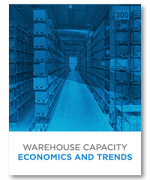Dynamic Warehousing Strategies: On-Demand Warehousing For E-Commerce
There is a strong case that not only does dynamic warehousing offer a cost efficient way for small ecommerce retailers to offer high service levels in a flexible fashion, but in fact it is likely to become a standard way of contracting for warehousing.
Dynamic warehousing is a warehousing strategy consisting of purchasing warehousing services in a pay‐per‐use model, on an electronic marketplace.
This can be the entire warehousing strategy for a company, or it may be an activity that supplements an existing network built on long‐term contracts.
In either case, it allows the retailer to quickly adapt to variable demand and cost conditions.
Retailers only pay per‐unit costs for the services they use, thus avoiding capital expense: this is particularly useful in ecommerce, where retailers typically face high demand uncertainty while also being capital‐constrained.
Additionally, dynamic warehousing allows ecommerce retailers to rent small units of capacity in many parts of the country, enabling quick delivery to a large fraction of customers.
Over the last few years, information and communication technologies have led to the emergence of electronic marketplaces for a number of services and business activities.
The most famous of these is of course Uber, but these marketplaces exist for everything from simple human tasks to outsourced manufacturing abroad.
This phenomenon is perhaps most accurately called “platform capitalism”, and the most significant enabler of it has been the rise of cheap and high capacity information and communication technologies.
Recent trends suggest that platform capitalism is only going to grow, in both B2B and B2C settings, as companies focus on their core competencies and take advantage of the flexibility and cost benefits that come with a well‐functioning marketplace with multiple suppliers of all the services a business needs to operate.
Dynamic warehousing can therefore be seen as an instantiation of platform capitalism in the warehousing services industry.
As overall warehousing costs continue to rise, and rise at dramatically different rates in different parts of the country, dynamic warehousing offers emerging retailers the flexibility to compete in such an environment.
Of course, reserving and operating warehousing services is more complicated than hailing a ride on Uber, but that is where software systems and technology can provide efficient solutions.
This white paper introduces the concept of dynamic warehousing, and demonstrates its value via a case study.
What’s Related




Favorites





